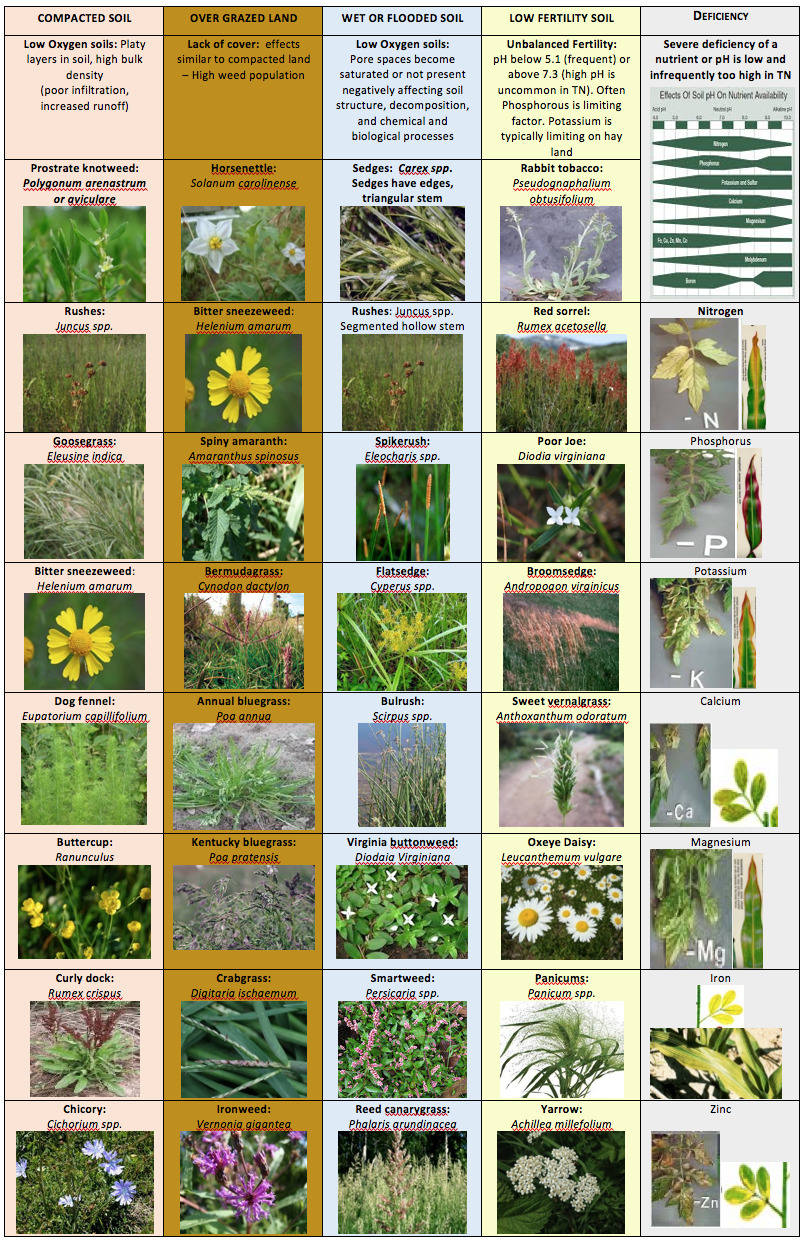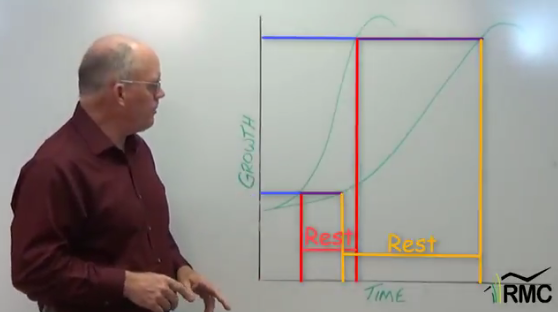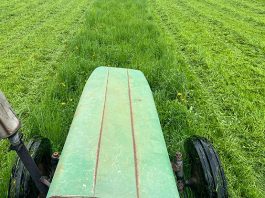Greg Brann, Natural Resources Conservation Service Grazing Specialist in Tennessee, recently sent some information out to his local farmers about “indicator plants” along with some tips for how to use that information to improve soil health and pasture quality. It’s good information for everyone to consider.
What Are Indicator Plants?
Indicator Plants are plants that, by their presence or abundance, can help us assess the quality of the site and what’s occurring below the surface. The chart below describes what the plants you see are telling you about what’s happening below the surface. (Click on the chart to get a larger, more readable version.)
Now that you’ve got this information, here’s what you can do with it:
Compacted Soils
You need more roots, both fibrous and tap roots. Start by maintaining living roots in your soil year-round by allowing plants to recover longer between grazing and mowing so that roots can recover as well. All plants help reduce issues with compaction but the following plants are especially known for decreasing soil compaction:
Cool season annuals: forage radish and cereal rye
Cool season perennials: alfalfa, chicory, red clover and sweet clover
Warm season annuals: sorghums
Warm season perennials: native warm season grasses like big bluestem, little bluestem, indiangrass, switchgrass and eastern gamagrass. Bermudagrass is tolerant of overgrazing and rather drought tolerant but doesn’t have as deep a root system as natives and needs nutrients for production.
Overgrazed Land:
Longer recovery between grazing improves vigor of plants. If grazing, skip a paddock, resting it for up to 90 days in the growing season and up to 210 days in the winter. Lowering stocking rate will remove stress on the the grass, soil, livestock and you. Fertilizing, feeding over winter, increasing the number of paddocks and rotating more often, leaving minimum heights of grass for soil protection, improved infiltration, lower soil temperature and improved water management is important as well will all reduce the impacts of overgrazing and shallow root systems. When minimum grazing heights are reached (as shown below), confine livestock to 20% or less of the land and feed hay till other paddocks reach a minimum height of 8” then resume grazing. Graze paddocks so that livestock don’t get the chance at a second bite of the same plant. In general the minimum recovery time or rest period between grazings is 14 days but base the rotation on height don’t graze below 4” (minimum of 4 layers of leaves).

Wet or Flooded
NRCS does not encourage draining land. Wetlands are very important ecosystems and aquifer recharge areas. If you’re considering draining land, check with your local NRCS office to make sure you won’t lose USDA benefits or be fined by other agencies. If you’re going to use an area, don’t graze or travel on wet or saturated soil. Drive only in designated areas controlling traffic. If you must enter a field when it is wet walk or use an ATV. Keep in mind that wide tires compact less than narrow tires.
Forage species that are adapted to wet and flooded land are: cereal rye, hairy vetch, alsike clover, red top, switchgrass and eastern gamagrass.
Low Fertility Soil
A plant tissue test may be in order to determine the deficiency. Contact the lab prior to sending in the sample. Feeding hay on low fertility relocates nutrients to the feeding site. Move or unroll hay in a new location each time you feed. High density short duration grazing improves manure distribution which improves fertility. Adjust pH to the desired level prior to applying deficient nutrients. You can move fertility in the animal as well by grazing a fertile field then rotating to one less fertile the manure dropped will be from the more fertile field. Plants, cover and roots aid in making more nutrients actively available to plants.
Plants adapted to low fertility include: cereal rye, lespedezas and native grasses.
Changes Take Time
Of course, past management has a dramatic effect on the plant community and the plant community doesn’t change quickly, thanks to a persistent seedbank. That means that some indicator plants may persist after management has improved. As an example, a low fertility site may still have broomsedge or rabbit tobacco on it even though fertility has improved. Soil testing, rest and recovery, more cover, seeding or other soil management methods may be required to alter the site to the desired state. The best weed control is out-competing undesirable plants. I always say, “Manage for what you want, not for what you don’t want.”
Want to Know More About What Kind of Soil You’ve Got?
While you can improve your soil to some degree, not all soils are created equal. Check out the NRCS’s web soil survey to find out what you’re starting with and get an idea of what it is capable of doing for you.






Hi. I build my own compost piles. Compost is an important resource and can drastically change the results of a garden. It is best to add compost to soil a week before plant. Thanks so much for your article. That’s what i need.
What does western ragweed indicate?
Comments are closed.